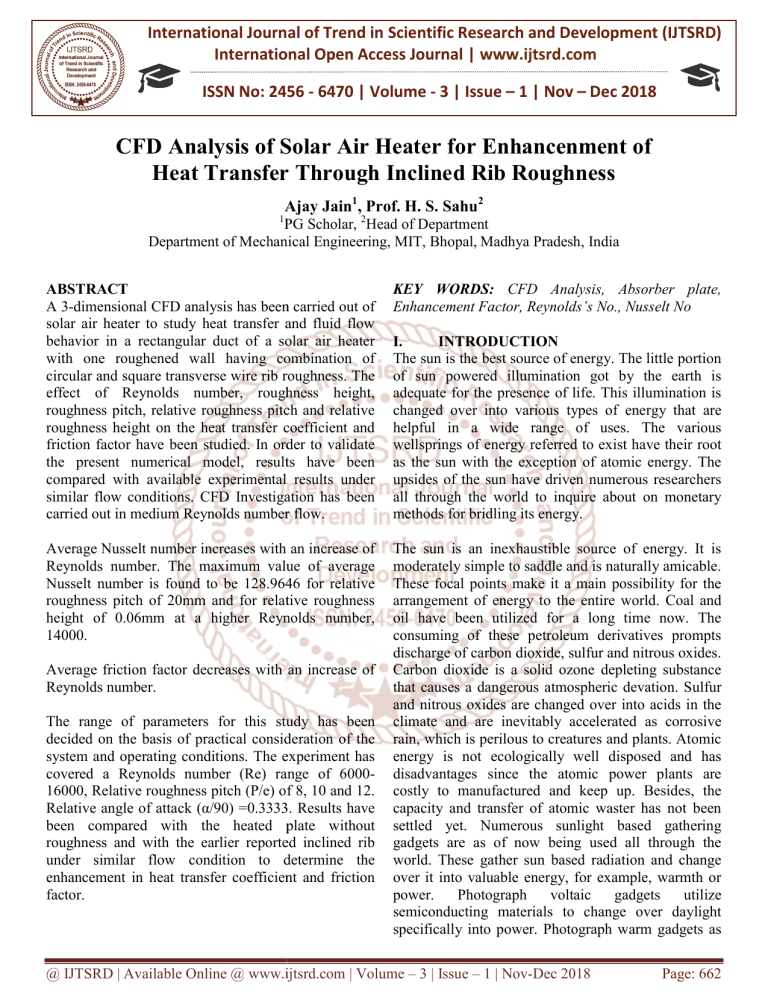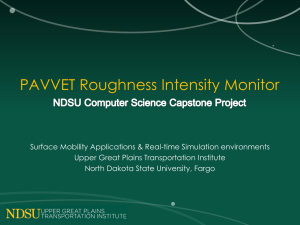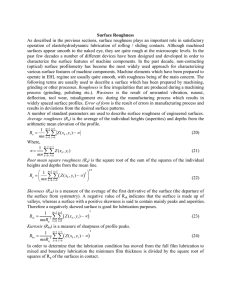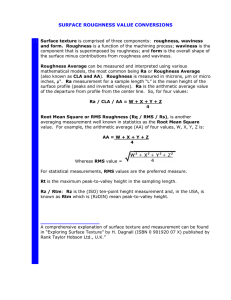
International Journal of Trend in Scientific Research and Development (IJTSRD)
International Open Access Journal | www.ijtsrd.com
ISSN No: 2456 - 6470 | Volume - 3 | Issue – 1 | Nov – Dec 2018
CFD Analysis of Solar Air Heater ffor Enhancenment of
Heat Transfer Through Inclined Rib Roughness
1
Ajay Jain1, Prof. H. S. Sahu2
PG Scholar, 2Head of Department
Department
ment of Mechanical Engineering, MIT, Bhopal, Madhya Pradesh,
Pradesh India
ABSTRACT
A 3-dimensional
dimensional CFD analysis has been carried out of
solar air heater to study heat transfer and fluid flow
behavior in a rectangular duct of a solar air heater
with one roughened wall having combination of
circular and square transverse wire rib roughness. The
effect of Reynolds number, roughness height,
roughness pitch, relative roughness pitch and relative
roughness height on the heat transfer coefficient and
friction factor have been studied. In order to validate
the present numerical model, results have been
compared with available experimental results under
similar flow conditions. CFD Investigation has been
carriedd out in medium Reynolds number flow.
KEY WORDS: CFD Analysis, Absorber plate,
Enhancement Factor, Reynolds’s No., Nusselt No
Average Nusselt number increases with an increase of
Reynolds number. The maximum value of average
Nusselt number is found to be 128.9646 for relative
roughness pitch of 20mm and for relative roughness
height of 0.06mm at a higher Reynolds number,
14000.
The sun is an inexhaustible source of energy. It is
moderately simple to saddle and is naturally amicable.
These focal points make it a main possibility for the
arrangement of energy to the entire world. Coal and
oil have been utilized for a long time now. The
consuming of these petroleum derivatives prompts
discharge of carbon dioxide, sulfur and nitrous oxides.
Carbon dioxide is a solid ozone depleting substance
that causes a dangerous atmospheric devation. Sulfur
and nitrous oxides are changed over into acids in the
climate and are inevitably accelerated as corrosive
rain, which is perilous to creatures and plants. Atomic
energy is not ecologically well disposed and has
disadvantages
vantages since the atomic power plants are
costly to manufactured and keep up. Besides, the
capacity and transfer of atomic waster has not been
settled yet. Numerous sunlight based gathering
gadgets are as of now being used all through the
world. These gather
her sun based radiation and change
over it into valuable energy, for example, warmth or
power.
Photograph
voltaic
gadgets
utilize
semiconducting materials to change over daylight
specifically into power. Photograph warm gadgets as
Average friction factor decreases with an increase of
Reynolds number.
The range of parameters for this study has been
decided on the basis of practical consideration of the
system and operating conditions. The experiment has
covered a Reynolds number (Re) range of 6000
600016000, Relative roughness pitch (P/e) of 8, 10 and 12.
Relative angle of attack (α/90) =0.3333.
0.3333. Results have
been compared with the heated plate without
roughness and with the earlier reported inclined rib
under similar flow condition to determine the
enhancement in heat transfer coefficient and friction
factor.
I.
INTRODUCTION
The sun is the best source of energy. The little portion
of sun powered illumination got by the earth is
adequate for the presence of life. This illumination is
changed
ged over into various types of energy that are
helpful in a wide range of uses. The various
wellsprings of energy referred to exist have their root
as the sun with the exception of atomic energy. The
upsides of the sun have driven numerous researchers
all through the world to inquire about on monetary
methods for bridling its energy.
@ IJTSRD | Available Online @ www.ijtsrd.com | Volume – 3 | Issue – 1 | Nov-Dec
Dec 2018
Page: 662
International Journal of Trend in Scientific Research and Development (IJTSRD) ISSN: 2456-6470
2456
a rule called sun powered authorities change over sun
based radiation into (warm transformation). Sunlight
based authorities are utilized to warm water and air
inside structures at bring down temperatures.
Solar collectors utilized for warming water and
cooling are primarily of flat-plate
plate sort. A flat
flat-plate
sun oriented gatherer is straightforward and cheap.
The most essential and basic piece of the flat plate
authorities is the safeguard surface. With a specific
end goal to boost the yield from the sun based
gatherers, the safeguard
ard ought to be frightfully
II.
LITERATURE SURVEY
SR.
TITLE
NO.
"Experimental study on heat transfer
1
and pressure drop in a channel with
triangular V-ribs,"
Thermal enhancement in a solar air
2
heater channel using rectangular
winglet vortex generators,"
Some thoughts on the transformation
3
of information and communication
technologies
"Design and development of compact
spiral ribbed cooling unit for
4
electronic chipsets with high power
densities,"
"Enhancement of forced convection
5
heat transfer from fin arrays with
circular perforation
"Numerical investigation of flow and
6
heat transfer characteristics from an
impinging jet on a circular cylinder,"
"Numerical investigation of flow and
7
heat transfer characteristics from an
impinging jet on a circular cylinder,"
8
9
"Forced convection air cooling in
porous graphite foam for thermal
management applications,"
particular. It ought to ingest however much of the
approaching sun powered radiation as could be
expected and in the meantime hold the gathered
warmth. This implies it should display high sun
oriented absorptance and low warm emittance.
em
Warm
misfortunes because of conduction, convection and
radiation affect the proficiency of sun oriented
safeguards. Other attractive properties of sun powered
safeguards are that they ought not debase
fundamentally amid the lifetime of the authority
authori and
that they ought to withstand cruel natural conditions.
AUTHORS
D. Jansangsuk, C.
Khanoknaiyakarn
and P. Promvonge,
N. Depaiwa, T.
Chompookham and
P. Promvonge,
Hequan Wu, "
C. S. Woei, C. K.
Feng, W. Huiru, H.
C. Chin and K. J.
Ken,
K. H. Dhanawade
and H. S.
Dhanawade,
Faghani, M.
Eskandari and E.
Faghani,
P. Faghani, M.
Eskandari and E.
Faghani,
K. C. Leong, L. W.
Jin, H. Y. Li and J.
C. Chai,
"Comparative Investigation on the
. Jie-min, F. Yi-feng,
Cooling Effect of Swirling Impinging Y. Ying, T. Juan, H.
Jet using Experimental and Numerical
Bing-ting and C.
Methods,"
Xiao-ling,
III.
PROBLEM IDENTIFICATIONS
To make solar air heater more efficient there is in
need of increase in heat transfer capability in SAH
duct which can be done by creating turbulence in
YEAR
2010
2010
2011
METHODOLOGY
transfer and pressure drop in
a channel with triangular VV
ribs
enhancement in a solar air
heater channel using
rectangular winglet
transformation of
information and
communication technologies
2011
development of compact
spiral ribbed cooling unit
2011
heat transfer from fin arrays
with circular perforation
2010
Numerical investigation of
heat transfer characteristics
on a circular cylinder
2010
Numerical investigation of
heat transfer
2008
2007
convection air cooling in
porous graphite foam for
thermal management
applications
Cooling Effect of Swirling
Impinging Jet using
Experimental and Numerical
Methods
a duct by introducing artificial roughness
geometry in it.
All above paper has performed in solar air
a heater
in the different type of ribs like square, triangular,
@ IJTSRD | Available Online @ www.ijtsrd.com | Volume – 3 | Issue – 1 | Nov-Dec
Dec 2018
Page: 663
International Journal of Trend in Scientific Research and Development (IJTSRD) ISSN: 2456-6470
2456
semicircular, circular, V-shaped,
shaped, Dimple shaped,
Chamfered, transverse wedge shaped, metal grit
ribs, inclined ribs, multi V-shaped
shaped ribs etc.
in different type of pitch, height and different in
Reynolds number. Some are performed in
experimental investigation and some are in CFD
analysis in different type of CFD code ANSYS
FLUENT like 12.1, 14.1 etc. which have different
type of heat transfer and thermo
thermo-hydraulic
performance in result.
The application of artificial roughness geometry
(in different shapes) has been recommended to
enhance the heat transfer coefficient by several
investigators.
Optimum geometry for heat enhancement study of
heat transfer
sfer and fluid flow behavior in a
rectangular duct for heat transfer and fluid flow.
To evaluate the effect of Reynolds number,
roughness height, roughness pitch relative
roughness pitch and the heat transfer coefficient
and friction factor can be evaluated.
Validation of results of previous studies in the
present numerical models available experimental
results under similar flow conditions to results of
CFD analysis.
Geometry of plate its effect on heat transfer rate
and thermal resistance.
IV.
METHODOLOGY
It is a known algorithm and used in many CFD codes.
SIMPLE can be used to more efficiently use computer
processing time (even though there are more
calculations) since it uses the correct value for
pressure. For specific sorts
orts of flow, SIMPLEC and
PISO can be similarly as productive as SIMPLER.
Which calculation to utilize relies upon the particular
case being examined: the stream conditions, level of
reliance of energy and scalars, and the particular
numerical plans utilized.
ed. This flow chart is common
flow chart for the all type of solution like segregated
pressure based solution, pressure based coupled
solution, and density based coupled solution. The
coupled based method steps are shown in the flow
chart.
Figure 1: Flowchart illustrating FLUENT solver algorithms
Where: - PBCS-Pressure
Pressure based coupled solution, DBCS
DBCS-Density
Density based coupled solution
V.
RESULTS AND ANALYSIS
This presents the anticipated air flow speed, weight
and temperature profiles amid Forced
Forced-wind current
over rib geometry in the duct which were consider in
this examination work. The CFD examination has
been performed for blend of round and square ribs on
safeguard plat of SAH and result has been contrasted
and the instance of smooth duct working under similar
Conditions to assess the improvement in heat transfer.
The data collected using ANSYS FLUENT 14.5
included the temperature distribution, pressure
distribution and airflow velocity at all node points in
the model duct. We can see the following result
@ IJTSRD | Available Online @ www.ijtsrd.com | Volume – 3 | Issue – 1 | Nov-Dec
Dec 2018
Page: 664
International Journal of Trend in Scientific Research and Development (IJTSRD) ISSN: 2456-6470
2456
Figure 2: Temperature distribution over smooth surface
Figure 3: Velocity vector contour over smooth surface
Figure
gure 4: Temperature distribution over inclined surface
Table 1: CONTINUOUS INCLINED P=20mm
Ti
To
Tf
Tp
Re
Q
h
Nu
300
332
316
404.86 6000 344.3089 19.37367 35.06634
300 325.87 312.935 379.22 8000 371.1363 27.99549 50.67184
300 322.4
311.2
362.3 12000 482.0324 47.1656 85.36973
300 318.65 309.325 348.56 14000 468.2242 59.6692 108.0012
Nu(exp)
32.27887
47.16964
80.51124
98.65806
@ IJTSRD | Available Online @ www.ijtsrd.com | Volume – 2 | Issue – 6 | Sep-Oct 2018
f(exp)
0.017829
0.016973
0.015836
0.015424
Page: 665
International Journal of Trend in Scientific Research and Development (IJTSRD) ISSN: 2456-6470
2456
Ti
300
300
300
300
Table 2: DISCRETE INCLINED P=24mm
To
Tf
Tp
Re
Q
H
340.56 320.28 388.26 6000 436.4115 32.09852
331.25 315.625 364.96 8000 448.3188 45.43618
322.35 311.175 351.01 12000 480.9564 60.36857
317.62 308.81 341.03 14000 442.3651 68.6476
VI.
CONCLUSIONS & FUTURE SCOPE
Average Nusselt number increases with an increase of
Reynolds number. The maximum value of average
Nusselt number is found to be 128.9646 for relative
roughness pitch of 20mm and for relative roughness
height of 0.06mm at a higher Reynolds number,
14000. Average friction factor decreases with an
increase of Reynolds number.
The range of parameters for this study has been
decided on the basis of practical consideration of the
system and operating conditions. The experi
experiment has
covered a Reynolds number (Re) range of 6000
600016000, Relative roughness pitch (P/e) of 8, 10 and 12.
Relative angle of attack (α/90)) =0.3333. Results have
been compared with the heated plate without
roughness and with the earlier reported inclined rib
under similar flow condition to determine the
enhancement in heat transfer coefficient and friction
factor.
Still there is a scope of increasing the heat transfer
and fluid flow characteristics of solar air heater by
providing artificial roughness on the rectangular duct.
As explained and discussed the effect of roughness
height and relative roughness pitch on tthe heat
transfer characteristics we can analyse more
parameters by using CFD analysis. In order to
validate the present numerical study, the results have
been compared with the earlier reported experimental
results under similar flow conditions. In future there is
many other parameter used to develop the roughness
geometries will analyse to see the effect on heat
transfer coefficient. Only few 3-D
D analyses has been
done so far to analyse the different artificial
roughness, hence still there is an scope of aanalysing
different geometries with different geometrical
parameters.
VII. REFERENCES
1. D. Jansangsuk, C. Khanoknaiyakarn and P.
Promvonge, "Experimental study on heat transfer
and pressure drop in a channel with triangular V
Vribs," Proceedings of the International
ational Conference
on Energy and Sustainable Development: Issues
Nu
58.09832
82.23949
109.2671
124.2522
and Strategies (ESD 2010),
2010) Chiang Mai, 2010, pp.
1-8.
2. N. Depaiwa, T. Chompookham and P.
Promvonge, "Thermal enhancement in a solar air
heater channel using rectangular winglet vortex
generators," Proceedings of the International
Conference on Energy and Sustainable
Development: Issues and Strategies (ESD 2010),
2010)
Chiang Mai, 2010, pp. 1-7.
7.
3. Hequan Wu, "Some thoughts on the
transformation of information and communication
technologies," 2011 IEEE
IEE
Technology Time
Machine Symposium on Technologies Beyond
2020,, Hong Kong, 2011, pp. 1-1.
1
4. C. S. Woei, C. K. Feng, W. Huiru, H. C. Chin and
K. J. Ken, "Design and development of compact
spiral ribbed cooling unit for electronic chipsets
with high power densities,"
sities," 2011 27th Annual
IEEE Semiconductor Thermal Measurement and
Management Symposium,, San Jose, CA, 2011, pp.
231-238.
5. K. H. Dhanawade and H. S. Dhanawade,
"Enhancement of forced convection heat transfer
from
fin
arrays
with
circular
perforation," Frontiers
ntiers in Automobile and
Mechanical Engineering -2010, Chennai, 2010,
pp. 192-196.
6. P. Faghani, M. Eskandari and E. Faghani,
"Numerical investigation of flow and heat transfer
characteristics from an impinging jet on a circular
cylinder," 2010
12th
IEEE
Intersociety
Int
Conference on Thermal and Thermo mechanical
Phenomena in Electronic Systems,
Systems Las Vegas,
NV, 2010, pp. 1-7.
7. K. C. Leong, L. W. Jin, H. Y. Li and J. C. Chai,
"Forced convection air cooling in porous graphite
foam for thermal management applications," 2008
11th Intersociety Conference on Thermal and
Thermo mechanical Phenomena in Electronic
Systems,, Orlando, FL, 2008, pp. 57-64.
57
@ IJTSRD | Available Online @ www.ijtsrd.com | Volume – 3 | Issue – 1 | Nov-Dec
Dec 2018
Page: 666
International Journal of Trend in Scientific Research and Development (IJTSRD) ISSN: 2456-6470
2456
8. Jie-min, F. Yi-feng,
feng, Y. Ying, T. Juan, H. Bing
Bingting and C. Xiao-ling,
ling, "Comparative Investigation
on the Cooling Effect of Swirling Impinging Jet
using
Experimental
and
Numerical
Methods," 2007 International Symposium on High
Density packaging and Microsystems Integration,
Shanghai, 2007, pp. 1-5
9. Z. Jie-min, F. Yi-feng,
feng, Y. Ying, T. Juan, H. Bing
Bingting and C. Xiao-ling,
g, "Comparative Investigation
on the Cooling Effect of Swirling Impinging Jet
using
Experimental
and
Numerical
Methods," 2007 International Symposium on High
Density packaging and Micro system Integration,
Shanghai, 2007, pp. 1-5.
10. Sahu MM, Bhagoria JL. Augmentation
Aug
of heat
transfer coefficient by using 90 broken transverse
ribs on absorber plate of solar air heater. Renew
Energy 2005; 30:2057–63.
63.
11. Gupta D, Solanki SC, Saini JS. Thermo hydraulic
performance of solar air heaters with roughened
absorber plates. Solar Energy 1997;
1997 61:33–42.
@ IJTSRD | Available Online @ www.ijtsrd.com | Volume – 3 | Issue – 1 | Nov-Dec
Dec 2018
Page: 667




